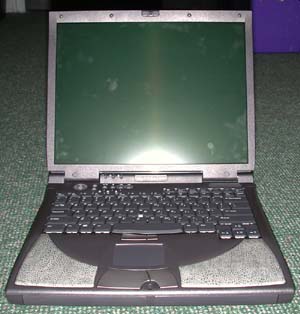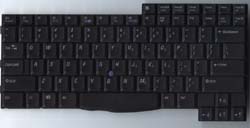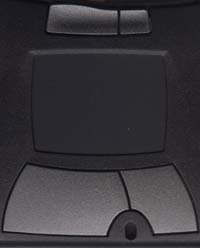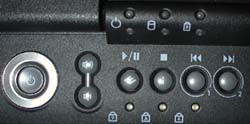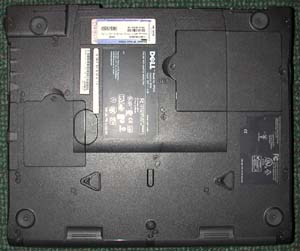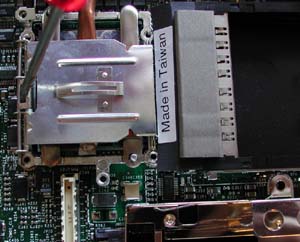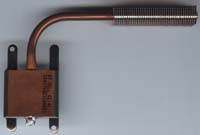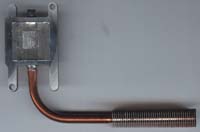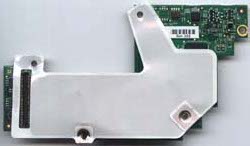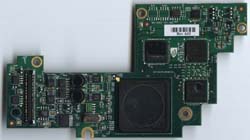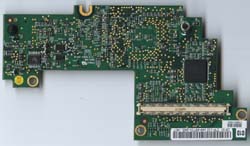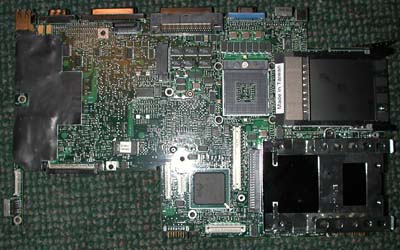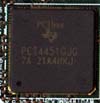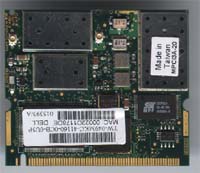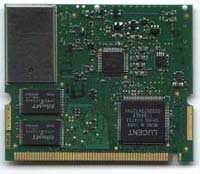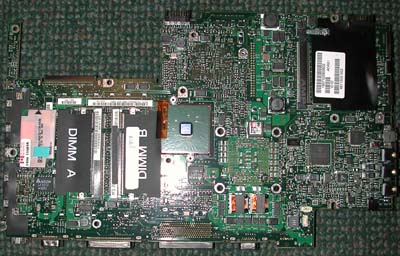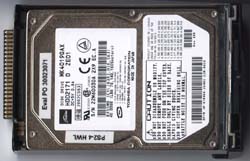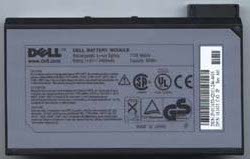
Original Link: https://www.anandtech.com/show/1019
Dell Inspiron 8200 Pentium 4-M 2.0GHz
by Matthew Witheiler on October 23, 2002 4:29 AM EST- Posted in
- Laptops
As the world's largest PC manufacturer, Dell has played an important role in ensuring the personal computer's success. It all started in 1985 with the release of the 8088 Dell Turbo. This computer was the first in a long line of quality computers and computing components that have allowed Dell to reach milestones other computer manufacturers only dream of: internet sales of $50 million per day, the number 1 PC manufacturer in global market share, and a staff of approximately 36,000 around the world. With all the success Dell has enjoyed, they must be doing something right.
Dell's success is on a large part based on the services and quality that the company offers; services and quality that other PC manufactures have trouble matching. Choosing a Dell computer means that you will be able to configure the system to your specific needs, have access to technical support 24 hours a day 7 days a week, be able to get driver and software updates on a regular basis, and own a product backed by the largest PC producer. As much as it may sound like an advertisement, Dell is doing things right. Going with any number of Dell machines, from the desktop Dimension, notebook Inspiron, or server class PowerEdge, is a pretty safe bet.
One area where Dell has managed to capture a good number of high-end computer users is on the notebook side of things. Many high-end computer users opt to build their own desktop systems as opposed to buying an assembled computer from an OEM. Attempting to do the same thing with a notebook, build one from parts, is essentially impossible. For this reason, even high-end and experienced computer users turn to companies like Dell to provide them with a notebook matching their needs.
Dell offers a number of notebook solutions: the home-class Inspiron, the office-class Latitude, and the workstation-class Precision. Among the most powerful of the solutions Dell offers is the Inspiron 8200, a notebook Dell calls an "advanced multimedia notebook... packed with cutting edge multimedia features." We were recently given the opportunity to take a look at a fully loaded Inspiron 8200 outfitted with a 2.0GHz Mobile Pentium 4-M processor, 512MB of PC2100 DDR memory, a 5400RPM hard drive, and both an NVIDIA GeForce4 440 Go and an ATI Mobility Radeon 9000 (we were given the opportunity to test the system with both video products). Follow us as we take a look at what turned out to be the most able desktop replacement notebook we have seen to date.
Construction - Build, Appearance, Size
The Dell Inspiron series notebooks have been around for a number of years now and have become Dell's staple high performance notebook. The Inspiron series is actually very similar to the business class Latitude series; the major difference between the two being the frequency which hardware and software modifications are made to the systems. While the Inspiron typically benefits from new drivers and updated hardware on a regular basis, the Latitude computers are more conservative as to prevent IT headaches resulting from a frequently changing line of PCs. The Inspiron 8200 that we got our hands on was a clear demonstrate of Dell's commitment to new technology: the notebooks featured almost every high-end component available for mobile systems.
The styling of the Inspiron 8200 is fairly conservative. The three spindle body maintains the look that previous Inspiron models had. The outer casing is plastic in its entirety with metal accents on the top of the notebook for the Dell and Inspiron logos. The casing is almost uniformly black accented with gray buttons and configurable color palm rest inserts. Any current or former Dell notebook owner should feel right at home with the Inspiron 8200's design.
The system is opened by pushing in on a small latch on the Inspiron 8200's screen. The locking mechanism is simple and seems to do a good job of keeping the unit closed when not in use. Releasing the latch and opening up the Inspiron 8200 gives access to the nicest LCD panel we have seen yet on a laptop. Our Dell Inspiron 8200 came with a 15.0" Dell UltraSharp UXGA LCD monitor which is Dell's highest end mobile display panel. The UltraSharp UXGA TFT LCD panel offers superior brightness, contrast ratio, response time, and viewing angles compared to standard UXGA panels. The 1600x1200 SuperSharp screen features a brightness rating of 180 cd/m^2 compared to a 150 CD/m^2 brightness rating of Dell's standard UXGA panel. The horizontal and vertical viewing angles are greatly improved over the standard panel (+/- 70 degrees vs +/- 40 degrees in the horizontal, +50/-60 degrees Vs +10/-30 degrees in the vertical) as is the contrast ratio (400:1 Vs 250:1). The numbers look impressive on paper but in order to truly appreciate the Dell UltraSharp display it has to be seen in person. The 15" UltraSharp display running at 1600x1200 is a thing of beauty and is well worth the $50 extra that it costs over a standard UXGA display.
Below the 15" display lies the Inspiron's keyboard: a full featured 85-key keyboard with dedicated arrow keys. They keyboard has a great feel. Thanks to the unit's large size key travel is plentiful. We found the keyboard layout very comfortable as it is very similar to the layout of a standard desktop keyboard. The keyboard also features an integrated pointing stick as a second input method. The pointing stick is located between the bottom of the G and H keys and right above the B key. The pointing stick also features its own set of buttons below the space bar. The pointing stick is a nice feature to have since it provides an alternative to the touchpad that most notebooks come with.
The Inspiron 8200 also comes with a fairly standard touchpad. The touchpad surface area proved to be spacious and the large buttons made clicking easy. The one complaint we had with the touchpad configuration on the Inspiron 8200 is the lack of a dedicated scroll button. We have seen a number of notebooks from Compaq, Sony, WinBook, and more that incorporate a scroll button into the touchpad allowing for at least vertical scroll and occasionally horizontal scrolling. With the large size of the Inspiron 8200's mouse buttons it does not seem that reserving some of this area for a scroll button would be all too hard.
To give the Inspiron 8200 a personalized touch, the system offers palm rest color inserts. The system comes standard with silver palm rests which can be replaced at any time in the computer's life by simply popping the existing inserts out and putting new ones in. The inserts have a soft rubber texture to them much like the palm rest area on the Compaq Presario series notebooks, making the rests comfortable. Our system came with silver alligator skin patterned inserts, one of eight inserts currently offered by Dell.
Above the keyboard lie the Inspiron 8200's function keys and status LEDs. There are a total of seven function buttons, beginning with the power button of the left followed by volume up and volume down buttons. The remaining 4 buttons can be set to operate in one of two modes via software. In application mode, the first button launches the Dell support page, the second button launches the default Internet browser, and the last two buttons can be programed to run any .EXE program file. In CD/DVD mode the buttons perform the functions pictured above them: button one play/pause, button two stop, button three track back, and button four track forward.
Below the function buttons are the keyboard status lights: num lock, caps lock, and scroll lock. There are also a set of LEDs above the keys, one for power status (solid when on, blinking while in standby), one for hard drive activity (on while hard drive is being accessed), and one for battery status (blinking while charging). There are two windows from which the top set of LEDs can be seen, a set on the inside panel and a set on the top of the laptop. This allows the LEDs to be seen while the screen is both closed and open.
The internal speaker on the Inspiron 8200 is found to the left of the power button. This should prove to be an effective location, as it is fairly far from where the hands rest while using the keyboard or touchpad.
On the far right side above the keyboard is a metal grill area. This serves to provide airflow across the CPU heatsink surface, as cool air drawn in from both this vent and a vent on the system's right side pass over the CPU heatsink and exit out the back.
Construction - Build, Appearance, Size (Continued)
Although it looks bare, the front of the Inspiron 8200 is actually home to two bays. The right bay is solely a battery bay, able to accept one of the unit's battery modules. On the left is a bay that in our system was home to a second internal battery but can also be used for a number of other expansion options, including a floppy drive ($20) and a 250MB ZIP drive ($249). The modules slide in and out with ease and going from the second battery to the floppy drive is as simple as hitting the release on the bottom of the system and swapping out one for another. This makes for easy upgrade paths down the road, as one can start with no device in the left bay initially and later get the extra battery or ZIP drive if necessary. We have not seen many notebooks at AnandTech that offer such easy expandability. One reason that Dell is able to offer such a feature is because of the Inspiron's size. We'll get to that in a bit, but for now keep in mind that all these extras that the Inspiron 8200 offers do add up.
The left side of the Inspiron 8200 has a number of components on it. First up on the left side is the unit's left speaker. This location is fairly ideal when it comes not notebook speaker position as it should prove to be difficult to block the sound output during normal use. To the left of the speaker are the unit's connection jacks: an ethernet jack followed by a modem jack. The ethernet jack has two lights above it to indicate connection status just like a desktop network would. The next port is a TV-output port. Powered by the internal video chip, be it the GeForce2 Go, GeForce4 440 Go or Mobility Radeon 9000, the TV-out pot can display either S-video or composite output. The final item on the left side of the system is the system's optical drive. Our Inspiron 8200 came with a 24x10x24x8x CD-RW/DVD combo drive but an 8X DVD drive and a 24X CD-RW drive are also available for less money ($149 less for the DVD, $99 less for the CD-RW). The drive is fairly fixed but can be slid out by removing a screw and pulling the drive from its bay.
As a desktop replacement notebook the Inspiron 8200 offers a number of ports, many of which are located on the system's back side. The back right side is home to a set of two USB 1.1 ports mounted one on top of the other. The ports are slightly recessed and are thus flush with the back of the system. The next four ports are located in a rectangular cut out area as to prevent them from sticking out beyond the notebook's casing. The first of these ports is a serial port, an item becoming increasingly rare on notebook machines. To the left of the serial port is a parallel port, followed by Dell's proprietary docking station port and finally a VGA-out port. The final two ports on the rear of the Inspiron 8200 are a single PS/2 port and an AC power port.
The back of the Inspiron 8200 is also the place where cooling of the system occurs. The system consists of two cooling fans mounted on the back left of the unit. The fans actually exhaust air, not blow it in. This explains the 138 degree Fahrenheit (58.9 degrees Celsius) temperature we measured at this location. Air is drawn in from the vent on the left side and top of the machine and forced over the CPU heatsink surface thanks to the two small fans. The fans only run when necessary and are controlled independently so if only one fan is required to cool the system, only one fan will be active. The fans can be rather noisy when both are running at full speed but for the most part the fans are off or only partially running.
The first item to notice on the Inspiron 8200's right side is the large cooling vent; it is from here that the majority of cold air is taken to cool the CPU. To the left of the vent are two PCMCIA slots. The system can accept two type II or one type III PCMCIA card and on a system this size we would not expect anything less. The PCMCIA slots lie above the Inspiron 8200's audio connections and firewire port. On the audio side of things there are three 3.8mm audio jacks: one for speakers out, one for headphones out and one for microphone in. To the left of these ports is a single unpowered 4-pin IEEE-1394 firewire port. We are seeing more and more high-end notebooks come with IEEE-1394 ports standard but personally we would rather have USB 2.0 ports on our laptop than a single unpowered firewire port.
The unit's hard drive is also on the right side of the machine. The drive slides out fairly easily simply by removing a screw. The IR window is also found on the hard drive mounting bay. Finally, the front right side of the system is home to the right speaker.
There are two access panels on the bottom of the Inspiron 8200 along with two release levers. The two release levers serve as the battery and multibay release mechanisms and are very easy to operate. The access panel on the left side of the system is home to the MiniPCI slot. In the case of our system this slot was occupied with a 802.11b wireless network card which we will discuss in more depth in the Under the Hood section.
The back right access panel gives access to the units two 200-pin SODIMM slots as well as the internal modem.
As a full featured, very powerful desktop replacement notebook, it should be of little surprise that the Inspiron 8200 is very large. The system measures 1.75" x 13.03" x 10.8" and weighs 7.9 pounds with the CD-ROM and floppy drive installed. Remove the floppy drive and replace it with an extra battery like the one in our system and expect to tack on about another half pound to the system weight.
The Dell Inspiron 8200 is big, heavy, and cumbersome. As a desktop replacement machine that travels infrequently the machine's weight and size should be only a minor inconvenience. However, if you plan on carrying the Inspiron 8200 on the road with you, you better start lifting weights now; all this power and convenience comes at a price.
Construction - Under the Hood
The Inspiron 8200 that Dell provided us with came loaded with some of the most powerful components available in laptops today. Our test Inspiron 8200 came with a Mobile Pentium 4-M 2.0GHz processor, 512MB DDR memory, a 40GB 5400RPM hard drive, an internal DVD/CD-RW drive, and the latest mobile graphics processors provided via a an NVIDIA GeForce4 440 Go mobile graphics module and an ATI Mobility Radeon 9000 graphics module (replaceable mobile graphics boards that are proprietary to Dell).
The 2.0GHz Mobile Pentium 4-M at the heart of our Inspiron 8200 is the second fastest mobile Intel CPU out there currently, second to the recently announced Mobile Pentium 4-M running at 2.2GHz. At 2.0GHz, the Mobile Pentium 4-M provides plenty of processing power. As you will recall from previous mobile articles, the Mobile Pentium 4-M processors are the same as desktop Northwood Pentium 4 processors with the addition of SpeedStep technology. On identical systems on AC power, a Mobile Pentium 4-M should perform exactly like a desktop Pentium 4 clock for clock. Making the Mobile Pentium 4-M processor more at home in a mobile environment is the addition of SpeedStep technology. In the case of the 2.0GHz Mobile Pentium 4-M processor, SpeedStep gives the processor the ability to dynamically clock itself between the full clock speed of 2.0GHz and the power saving speed of 1.2GHz.
The CPU in the Inspiron 8200 may not be advertised as end-user upgradable but it is fairly easy to get to, like many other internal system components. The CPU along with other major internal components are located under the keyboard which is easily removed by unscrewing four screws. Although this design was likely implemented to make it easier for Dell to replace broken components if necessary, it helps the knowledgeable computer user gain access to some of essential internal components. For example, the CPU socket and heatsink retention mechanism is by far easier to use than the ones we have seen on other laptops.
To remove the CPU heatsink and gain access to the CPU, all one needs to do is use a flat head screwdriver to pry up a small metal bar that holds the heatsink on top of the CPU. Replacing the heatsink is even easier: simply push down on the locking mechanism and it snaps into place.
The CPU is cooled via a fairly small heatsink that is connected to the CPU surface via a copper heatpipe. The heatpipe runs from a metal square that sits on top of the CPU core to the finned heatsink surface. The heatsink proved to be much smaller than the heatsinks we have seen on other Mobile Pentium 4-M notebooks. How is Dell able to get away with using such a small heatsink on such a hot processor?
The secret is in the active cooling that the Inspiron 8200 employs. The long rectangle that is the heatsink is covered in its entirety by two 30x30x6 fans that are each able to spin at up to 8,000RPM and move up to 3.7CFM of air across the heatsink surface. The fans are independently temperature controlled, so the fans can be completely off, have one running at partial speed, have both running at partial speed, or have both running at full speed. We found that under most 2D situations the fans remained off or blew only for a short time before turning off. Under stressful situations like 3D gaming, both fans ran at high speed a good amount of the time.
The CPU is mounted in a Molex type socket that allows for easy removal of the chip with the twist of a screw.
A unique feature of some Dell notebooks is the use of a a removable graphics module. All other notebooks we have seen locate the graphics chip and memory directly on the motherboard, saving space. The Inspiron 8200, on the other hand, uses a discrete board that includes both the GPU and the graphics memory. This video board then connects to the motherboard via a connector that carries the AGP bus signals. The video card's BIOS information and power circuitry are also stored on this card, so a card of one type can easily be replaced with a card of another type. Again, this mobile video module was most likely implemented to make it easy for Dell to produce machines of various configurations but it also gives the knowledgeable computer user the potential to upgrade down the road. Changing from the standard GeForce2 Go to the GeForce4 440 Go to the Mobility Radeon 9000 should prove to be no problem. The only problem is getting you hands on one of these proprietary Dell video modules.
Although our system came to us with an NVIDIA GeForce4 440 Go video module installed, we were also given the opportunity to test on the new ATI Mobility Radeon 9000 which is now the high-end video choice in the Inspiron 8200 (costing only $30 more than the GeForce4 440 Go). Unfortunately we did not have access to the Mobility Radeon 9000 module for an extended period of time so we were unable to record any numbers except for 3D performance numbers. We were also not able to get a picture of the Mobility Radeon 9000 module but it looks very similar to the GeForce4 440 Go module.
The video module comes with a heat spreading device installed on top of the GPU and memory. This heat spreader then makes direct contact with a small heatsink located under the keyboard to facilitate cooling.
Removing the white heat spreader reveals the GPU and three of the four BGA memory modules, with the remaining module lying on the bottom of the board.
Along with the video board connector, the system's Intel FW8280 southbridge is also mounted on the top of the motherboard. The southbridge is directly under the video board.
On the left side of the motherboard is a small plastic shield that is stuck on top of the motherboard. The shield serves to protect this area of the motherboard from having direct contact with the metal casing of the optical drive. Under this shield are two logic chips: a 3COM 920-ST06 10/100 ethernet controller and an SMSC LPC47N252 I/O controller.
Construction - Under the Hood (continued)
The back of the Inspiron 8200's motherboard is home to the remainder of components. Square in the middle of the motherboard's backside is the 845MP northbridge. The 845MP is simply the mobile version of the desktop 845DDR and, in fact, shares much in common with the desktop chipset. This gives the 845MP features such as a 400MHz processor bus, support for up to a 266MHz DDR memory bus, and support for external AGP 4X graphics. The warm-running northbridge is cooled via a metal plate that also serves as the bottom of the CPU heatsink mount.
To the left of the northbridge are the system's memory slots. The Inspiron 8200 offers two 200-pin DDR SODIMM memory sockets, both of which are accessible via an access panel on the bottom of the system. Our system came with a total of 512MB of PC2100 DDR memory provided by one 256MB stick of Toshiba memory and one 256MB stick of Micron memory. Both sticks offered a CL rating of 2.5.
 |
 |
To the left of the memory is the internal 56k modem which happens to be a an ActionTec MD560RD modem.
On the right side of the motherboard there are a few more logic chips. First up is a a Texas Instruments PCI4451 PCMCIA controller.
There is also a TI TSB41AB1 chip located to the upper left of the PCMCIA controller. This chip gives the Inspiron 8200 its IEEE-1394 support.
The final item of importance on the rear of the Inspiron 8200's motherboard is the MiniPCI slot which is located on the upper right side. In our system this slot was occupied by a Lucent WCND 802.11b MiniPCI card. In use the internal 802.11b network card actually provided better connectivity than our D-Link PCMCIA 802.11b card. The internal antenna that our Lucent WCND was connected to ran along the side of the system up to the front right side.
The Dell Inspiron 8200 is the first notebook we have been able to get our hands on that offers a 5400RPM hard drive. In our first notebook review, we showed just how big of a bottleneck a mobile hard drive is. We saw that performance of a system using a notebook drive can fall up to 15% compared to the same system running on a desktop drive. Obviously a faster hard drive will reduce this bottleneck and produce a system that is faster over all.
Although we did not compare the 5400RPM 40.0GB Toshiba MK4019GAX hard drive in our Inspiron 8200 to 4200RPM hard drives (that will be in its own review to be published soon), the specifications of the drive are impressive. The average seek time of the drive is 12ms compared to 13ms for a typical 4200RPM mobile hard drive, the average latency is 5.55ms compared to 7.14ms for many 4200RPM mobile hard drives, and the MK4019GAX offers a 16MB buffer compared to the 2MB buffer on many other notebook hard drives.
The high performance of the 5400RPM Toshiba MK4019GAX does come at a price. The power consumption of the drive is higher than that of 4200RPM hard drives, at a 5.0 watts start, 2.9 watts seeking, and 1.05 watts idle (compared to 2.7 watts, 2.45 watts, and 0.80 watts in a similar 4200 RPM drive).
Again, keep on the lookout for AnandTech's mobile hard drive roundup which should be published soon.
The speakers on the side of the Inspiron 8200 appear to be fairly standard notebook speakers. The sound quality proved to be on par with other notebook audio solutions.
The Inspiron 8200 makes use of decent sized 8-cell lithium-ion batteries. The system comes standard with one 66WHr battery rated at 4600mAh at 14.8V. A second battery can be installed in the modular bay. The battery includes a set of five LEDs mounted on the top edge that indicate battery status with the push of a button; useful in determining charge of extra batteries without having to put the battery in the system.
Features - Software
As is common with notebook systems from major manufacturers, the Dell Inspiron 8200 comes preloaded with a good amount of software. The 8200 series notebooks are available with either Windows XP Home Edition or Windows XP Professional. In the seven months since our first notebook review we have seen Windows XP replace older Microsoft operating systems as the default operating system on many notebook machines. We could not be more pleased with this trend as Windows XP is a good amount better than the Windows ME operating system that laptops used to come preloaded with. The default operating system on the Inspiron 8200 is Windows XP Home. Making the switch to Windows XP Professional costs an additional $79.
On top of the operating system, the Inspiron 8200 comes preloaded with extra software to make the computer more useful right out of the box. Each system comes preloaded with: Image Expert 2000 (60-day trial), WinDVD 3.2, Microsoft Encarta Standard 2002, Microsoft Works 6.0, MusicMatch Jukebox, Roxio Easy CD Creator 5, Microsoft Streets and Trips 2002, Microsoft Money 2002, and Microsoft Picture It! Photo 2002. We were pleased to see so many 3rd party software solutions come preloaded on the Inspiron 8200. The Microsoft software package, thanks mainly to Works 6.0, can help eliminate the cost of extra software. Although Works may not be a full featured or robust as Office, it does provide the user with a word processor and spread sheet application that can get the job done at a price that is just right: free.
The multimedia software selection of WinDVD 3.2, MusicMatch Jukebox, and Roxio Easy CD Creator 5 proved to be just right. We have always been pleased with WinDVD as a software DVD decoder and the addition of MusicMatch Jukebox is helpful for those looking to do some MP3 encoding and decoding. It was very nice to find Roxio Easy CD Creator 5 installed on the system. We have seen a number of notebook systems in the lap that turn to the built-in Windows XP burning feature for CD-R recording but we are wholly unimpressed with this solution. Although it gets the job done, the Windows XP burning software does not even come close to matching the ease and functionality offered by a 3rd party software solution such as Easy CD Creator 5.
The Test
As we mentioned before, we were given the opportunity to test the Dell Inspiron 8200 with both the NVIDIA GeForce4 440 Go video solution as well as the ATI Mobility Radeon 9000 video solution. The video solution in place during testing is noted in each graph with the exception of the 2D tests where the NVIDIA GeForce4 440 Go was the only product tested (2D performance of the two products is identical). Sadly we did not have access to the Mobility Radeon 9000 card for long enough to perform in-depth power analysis of the product (as we did in our GeForce4 440 Go review) but looks for a future AnandTech article to focus on just that.
We used an older version of Unreal Tournament 2003 in our tests. The benchmarks included in this review are based on a private build of the game (8/06/02). The code in this build of Unreal Tournament 2003 is very similar to the final version of the game and should give us a good understanding of how the Dell system will perform in the release version.
Finally, since we recently changed the settings that our Serious Sam 2 tests and Jedi Knight 2 tests are run at (extreme settings and high quality settings with anisotropic filtering disabled respectively) we could only compare the Dell system to a limited number of laptops in these games. This will change as we continue using the new benchmark settings. Since our 2D testing suite has not changed, the Inspiron 8200 is compared to a variety of other notebooks solutions AnandTech has seen.
Due to the number of notebooks we will be comparing the Dell Inspiron 8200 to, the test table only includes the specifications of the Dell Inspiron 8200 and the desktop we used to compare it to. For the specs of the other notebooks, please see those reviews (which can be found easily by clicking on the hyperlinks in the performance graphs).
|
|
Windows
XP Professional Test System
|
|
|
|
Hardware
|
|
|
Dell
Inspiron 8200
|
Desktop
System
|
|
| CPU(s) |
Mobile
Pentium 4-M 2.0GHz
|
Pentium
4 2.0GHz
|
| Motherboard(s) |
Dell
845MP DDR
|
|
| Memory |
512MB
PC2100
|
512MB
PC2100
|
| Hard Drive |
40.0GB
5400RPM Toshiba MK4019GAX
|
IBM
Deskstar DPTA-372050 20.5GB 7200 RPM
|
| CDROM |
DVD/CDRW
|
Philips
48X
|
| Video Card(s) |
ATI
Mobility Radeon 9000 64MB 128-bit DDR
NVIDIA GeForce4 440 Go 64MB 128-bit DDR |
NVIDIA
GeForce4 MX 440
|
| Ethernet |
3COM
920-ST06 Onboard Ethernet Adapter
|
Linksys
LNE100TX 100Mbit PCI Ethernet Adapter
|
|
|
Software
|
|
|
Operating System |
Windows XP Professional |
|
| Video Drivers |
ATI
7.75
NVIDIA 28.35 (latest for Dell) |
NVIDIA
40.72 Beta
|
|
|
Benchmarking Applications
|
|
|
Bapco
SysMark 2001 |
||
Performance - Overall Performance
|
Off the bat the the Dell Inspiron 8200 2.0GHz secures itself as the fastest performing notebook based off of a mobile processor that we have seen at AnandTech. The 2.0GHz Mobile Pentium 4-M is the second fastest mobile Pentium 4 processor available and it certainly does not disappoint. The Dell Inspiron 8200 with the 2.0GHz processor on a DDR memory bus was able to perform within 8% of the SDR based 2.4GHz WinBook J4 (based off a desktop processor running 400MHz faster). As we have seen in previous reviews, the performance of notebook systems are typically off that of a comparable desktop system. Our Dell Inspiron 8200 performed 26% slower than the 2.0GHz desktop system we configured. The difference in speed results from a number of issues present in notebooks (such as slower hard drives, less aggressive memory timings, ect), and is typically observed when comparing any laptop to a desktop system. The Inspiron 8200's next closest competitor, the Compaq Presario 2800T, fell back 4% in the Office Productivity portion of SYSMark 2002.
|
Again we see the the Dell Inspiron 8200 fall short of only one other mobile system: the desktop processor based WinBook J4. Thanks to its faster processor, the WinBook J4 performed 8% faster overall in SYSMark 2002. The Inspiron 8200 outperformed the next fastest system, the Compaq Presario 2800T, by 8%. Performance of the mobile system was 19% slower overall than the performance of the 2.0GHz desktop system. Again, this is a trend that we have seen throughout all mobile platforms.
Performance - Content Creation
|
The Internet Content Creation portion of SYSMark 2002 is fairly CPU intensive and as a result the Inspiron 8200 with its 2.0GHz processor performs well among the mobile systems. The Inspiron 8200 ran 12% faster than the Compaq Presario 2800T with a 1.7GHz processor. Thanks to its 2.4GHz desktop processor, the WinBook J4 remains performance king in this test, running 10% faster than the Inspiron 8200.
|
For months now we have been pointing out that notebook systems typically do poorly in Content Creation Winstone 2002 because the benchmark is fairly I/O intensive. We previously demonstrated how much performance can be lost thanks to a mobile drive and speculated that a faster hard drive would increase performance of a system in this test. The 5400RPM Toshiba drive that our Inspiron 8200 used gave the system a large performance boost in Content Creation Winstone 2002, suggesting that at least the Toshiba MK4019GAX 5400RPM drive reduces a major bottleneck in mobile systems: the I/O performance. Thanks to the hard drive, our Inspiron 8200 performance 18% faster than the next closest competition, which happened to be using a desktop processor running a full 400MHz faster. In fact, in this highly I/O intensive benchmark the Dell system only performed 5% slower than the desktop system we compared it to. If the Toshiba MK4019GAX is any indication it seems that 5400RPM mobile hard drives are just what notebooks have been waiting for.
Performance - MobileMark 2002
The Dell Inspiron 8200 is only the third mobile system we have put through BAPCo's new MobileMark 2002 benchmark. We previously discussed how MobileMark 2002 represented a big step forward for the mobile benchmarking world, enabling much needed Windows XP support and incorporating a full new suite of programs.
|
Since our Dell Inspiron 8200 shipped with two batteries, we tested the unit with one battery installed in each of the battery trays (for a total of two batteries). The two battery solution that the Inspiron 8200 provides creates for very impressive battery up times. The system with two batteries ran for a full five hours and five minutes: incredible considering the power that the 2.0GHz processor, 5400RPM hard drive, 15" LCD panel, and video card consume. The Dell Inspiron 8200 is certainly powerful but who would have guessed it can also run so long away from a power outlet?
To estimate performance of the Inspiron 8200 with only one battery we can take our two-battery run time and divide it by two, giving the run time of a single battery. This suggests that the Inspiron 8200 has a single battery run time of 2 hours and 32 minutes (152.5 minutes), meaning that the single battery life of the system is a bit lower than the competition. Perhaps this is one reason why Dell offers the ability to install two batteries in the system simultaneously.
Performance - Startup Times
|
The Inspiron 8200 2.0GHz was among the fastest machines we have seen when it come to starting up. At 32 seconds, the system went from a black screen to Windows XP Professional in only one second more than the fastest systems we have seen.
|
Following the boot trend, the Inspiron 8200 is only one second slower than the fastest machine to return from standby. The vast majority of systems come out of standby within one second of each other.
|
Interestingly, the Dell Inspiron 8200 falls in the middle of the pack when it comes to returning from hibernation mode. At 21 seconds, the system was five seconds slower than the leading ECS i-Buddie XP 2100+.
Performance - Unreal Tournament 2003
|
As we begin the 3D tests we can see that both video solutions provided by the Inspiron 8200 are a bit slower than a desktop GeForce4 MX 440 card. The Mobility Radeon 9000 solution performs 7% slower than the desktop 2.0GHz machine and the GeForce4 440 Go performs 19% slower. Comparatively, the Mobility Radeon 9000 ran 12% faster in this instance.
|
Again, the desktop GeForce4 MX 440 performed faster than both mobile solutions at 1024x768x32 in dm-Antalus. The Mobility Radeon 9000 was 9% slower than the desktop system and 8% faster than the GeForce4 440 Go.
|
The gap between the mobile system and the notebook shrinks at 1280x1024x32. Now the ATI Mobility Radeon 9000 is only 8% off the desktop and is 7% faster than the GeForce4 440 Go.
|
Switching to the dm-Asbestos demo shows something we have never before seen in a mobile review: a mobile system performing better than a comparably configured desktop one in 3D gaming. The Mobility Radeon 9000 has a 15% lead over the desktop GeForce4 MX 440 that we compared it to. The Inspiron 8200 with a Mobility Radeon 9000 at the helm seems to act as one powerful gaming machine.
|
The performance lead that the Mobility Radeon 9000 enjoys remains the same as the resolution is increased. The Inspiron 8200 with the Mobility Radeon 9000 also performs 25% faster than the GeForce4 440 Go.
|
The lead drops to 13% at 1280x1024x32 but remains equally impressive: the notebook is actually gaming faster than a decently configured desktop!
Performance - Unreal Tournament 2003 (continued)
|
The ctf-Citadel demo continues the trend was saw in the dm-Antalus, with the desktop machines outperforming the Inspiron 8200. The Mobility Radeon 9000 is 7% slower than the desktop 2.0GHz machine while the GeForce4 440 Go was 12% slower.
|
|
|
We were again excited to see the Inspiron 8200 with the Mobility Radeon 9000 outperform the desktop system we configured. Running 12% faster, the mobile system had little problem tackling one of today's toughest games at reasonable resolutions.
|
|
Performance - Unreal Tournament 2003 (continued)
|
The Inspiron 8200 with the Mobility Radeon 9000 beings with a slight lead over the desktop system. Will the lead last?
|
It appears not. The Inspiron 8200 falls behind both desktop systems, although by a small 2%.
|
The desktop gains a 6% lead at 1280x1024. At 27.5FPS, the resolution appears to be a bit high to smoothly run the intensive Inferno demo.
|
We see the Mobility Radeon 9000 Inspiron 8200 outperform the desktop machines once again, this time by 12%.
|
By 10% here...
|
And 11% here.
Performance - Serious Sam: The Second Encounter
Since we recently switched to testing Serious Sam: The Second Encounter under the extreme quality settings, we can only compare the Dell Inspiron 8200 to the desktop machines.
|
The performance lead that the Dell Inspiron 8200 enjoyed over the desktop machines had in some Unreal Tournament 2003 levels is all but gone in Serious Sam: The Second Encounter. At 800x600x32 the Inspiron 8200 with the Mobility Radeon 9000 was 18% slower than the 2.0GHz desktop machine while the GeForce4 440 Go Inspiron 8200 was 22% slower.
|
The performance gap shrinks at 1024x768x32, with the Mobility Radeon 9000 Inspiron 8200 performing 13% slower than the desktop and the GeForce4 440 Go Inspiron 8200 performing 22% slower.
|
Finally, at 1280x1024x32, the performance gap shrinks to 12% for the Mobility Radeon 900 equipped Inspiron 8200 and 19% for the GeForce4 440 Go equipped one.
Performance - Jedi Knight 2
|
The Dell Inspiron 8200 is certainly able to hold its own in Jedi Knight 2. At 800x600x32 the Mobility Radeon Inspiron 8200 is only 8% slower than the desktop machine with a GeForce4 MX 440 in it while the GeForce4 440 Go system is 17% slower.
|
The gap shrinks to 6% for the Mobility Radeon 9000 Inspiron 8200 at 1024x768x32 while it grows to 24% for the GeForce4 440 Go Inspiron 8200.
|
When the resolution is bumped up to 1280x1024x32, the Mobility Radeon 9000 Inspiron 8200 is again able to outperform the desktop system we chose to compare it to; this time by 6%. The GeForce4 440 Go model falls 27% behind.
Conclusion
Dell did not become the world's leading supplier of computers by producing sub par products or providing poor services. The company got where they are today by creating and selling powerful and attractive computers. The Dell Inspiron 8200 is only one example of the many quality solutions that Dell provides.
As a desktop replacement system, a loaded Dell Inspiron 8200 is among the best if not the best available. The power of system proved to be extremely impressive, rivaling the speed of desktops in many instances. Features such as the UltraSharp UXGA LCD display, fast processor options, and powerful video solutions, make the Inspiron 8200 the most able notebook system we have seen to date. We could easily see it acting as a full time desktop and a part time notebook.
We only have a two complaints about the Inspiron 8200. First, let's tackle the trivial complaint; a complaint that revolved around the styling of the Inspiron 8200. The design of the Inspiron series notebooks has changed very little in the past few years and we think it is high time for an upgrade. Although functional, the black plastic case is not very visually pleasing and reminds us of early IBM ThinkPad systems. The bulky lines and sharp angles on the system make it seem less like a state of the art computer and more like an aged one. Hopefully Dell has some new design plans for the Inspiron 8200's successor.
The second complaint we had about the Inspiron 8200 is less of a complaint and more of a warning for those out there considering the system. Although a notebook, the Inspiron 8200 is not very portable. Weighing in at over 8 pounds with both batteries installed, the Inspiron 8200 is not easy to take from point A to point B. Do not expect to be able to throw it in a bag and be on your way carefree. If the size of the Inspiron 8200 along your back doesn't get you, the weight it puts on your shoulders will. A thin-and-light system: no. An extremely powerful desktop replacement notebook: yes. It would be hard to be dissatisfied with the Inspiron 8200 if it served as a desktop system that traveled occasionally.
We would like to make one recommendation for those who may think that the Inspiron 8200 is for you: spend the extra money to deck the system out. In its base configuration the Inspiron 8200 is nice but offers few advantages over smaller and lighter systems from other manufacturers. Do yourself a favor and spend the extra money to go with at least the Mobility Radeon 9000 ($149 option), a 5400RPM hard drive (approximately a $100 option), 256MB of memory (a $75 option), and a a fairly fast processor (the 2.0GHz is a $150 option). If you really want to have the nicest system possible, spend the extra $180 to go with the UltraSharp display (especially if you will not be using an external monitor) and a $99 extra battery for exceptional battery life. The high-end options that the Inspiron 8200 offers is the quality of the system that makes it so impressive. We can assure you that the extra money spent now will be well worth it down the road.
With a fully equipped Inspiron 8200, who needs a desktop? Even the occasional or somewhat frequent gamer may apply.

